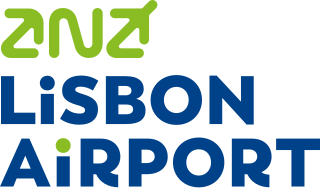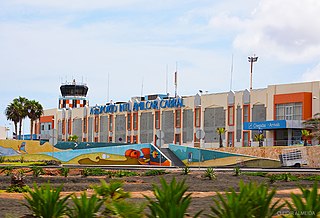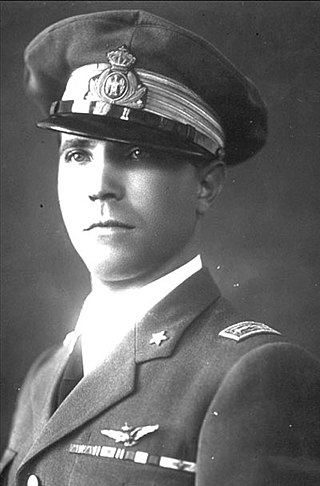
Pan American World Airways, originally founded as Pan American Airways and more commonly known as Pan Am, was an airline that was the principal and largest international air carrier and unofficial overseas flag carrier of the United States for much of the 20th century. It was the first airline to fly worldwide and pioneered numerous innovations of the modern airline industry, such as jumbo jets and computerized reservation systems. Until its dissolution on December 4, 1991, Pan Am "epitomized the luxury and glamour of intercontinental travel", and it remains a cultural icon of the 20th century, identified by its blue globe logo, the use of the word "Clipper" in its aircraft names and call signs, and the white uniform caps of its pilots.

Las Américas International Airport is an international airport located in Punta Caucedo, near Santo Domingo and Boca Chica in the Dominican Republic. The airport is run by Aeropuertos Dominicanos Siglo XXI (AERODOM), a private corporation based in the Dominican Republic, under a 25-year concession to build, operate, and transfer (BOT) six of the country's airports. Las Américas usually receives a wide variety of long-, mid-, and short-haul aircraft. Santo Domingo's other airport, La Isabela, is much smaller and used by smaller aircraft only.
A transatlantic flight is the flight of an aircraft across the Atlantic Ocean from Europe, Africa, South Asia, or the Middle East to North America, Latin America, or vice versa. Such flights have been made by fixed-wing aircraft, airships, balloons and other aircraft.

Humberto Delgado Airport, informally Lisbon Airport and previously Portela Airport, is an international airport located seven kilometres northeast of the city centre of Lisbon, the capital of Portugal. The airport is the main international gateway to Portugal. As of 2023, it was the 12th-largest airport in Europe in terms of passenger volume, and carried 190,700 tonnes of cargo. Lisbon Airport is also the main European hub to Brazil, the largest European Star Alliance hub to South America and also an important European hub to Africa.

Cabo Verde Airlines is an international airline based in Cape Verde. It connects three continents with non-stop flights from their hub at Amílcar Cabral International Airport on Sal Island.

British Security Co-ordination (BSC) was a covert organisation set up in New York City by the British Secret Intelligence Service (MI6) in May 1940 upon the authorisation of the Prime Minister, Winston Churchill.

Johan Adolf Pengel International Airport, also known as Paramaribo-Zanderij International Airport, and locally referred to simply as JAP, is an airport located in the town of Zanderij and hub for airline carrier Surinam Airways, 45 kilometres (28 mi) south of Paramaribo. It is the larger of Suriname's two international airports, the other being Zorg en Hoop with scheduled flights to Guyana, and is operated by Airport Management, Ltd./ NV Luchthavenbeheer.

Augusto Severo International Airport, originally called Parnamirim Airport, was the civilian airport that served Natal, Brazil, located in the adjoining municipality of Parnamirim. Starting on November 24, 1951, the airport was named after the aviator Augusto Severo de Albuquerque Maranhão (1864-1902).

Amílcar Cabral International Airport, also known as Sal International Airport, is the main international airport of Cape Verde. The airport is named after the revolutionary leader Amílcar Cabral. It is located two km west-southwest from Espargos on Sal Island. Sal is the main hub for the national airline, Cabo Verde Airlines; and serves as a base for carrier Cabo Verde Express. This airport was also one of NASA's locations for a facility to handle the Space Shuttle after reentering from orbit.

Ala Littoria S.A. was the Italian national airline that operated during the fascist regime in the 1930s and 1940s.

Deutsche Luft Hansa A.G. was a German airline. It served as flag carrier of the country during the later years of the Weimar Republic and throughout Nazi Germany, when it had close links to the Nazi Party.
Lati or LATI may refer to:

The Savoia-Marchetti SM.75 Marsupiale was an Italian passenger and military transport aircraft of the 1930s and 1940s. It was a low-wing, trimotor monoplane of mixed metal and wood construction with a retractable tailwheel undercarriage. It was the last of a line of transport aeroplanes that Alessandro Marchetti began designing in the early 1930s. The SM.75 was fast, robust, capable of long-range flight and could carry up to 24 passengers for 1,000 miles.

Panair do Brasil was an airline of Brazil. it ceased operations in 1965. Between 1945 and 1965, it was considered to be the largest carrier not only in Brazil but in all of Latin America.

The Savoia-Marchetti SM.95 was an Italian four-engine, mid-range transport aircraft, which first flew in 1943. It was the successor of the Savoia-Marchetti SM.75.

RAF Castel Benito was an airport of Tripoli created by the Italians in Italian Libya. Originally, it was a small military airport named Castel Benito, but it was enlarged in the late 1930s and was later used by the British RAF after 1943. It was called RAF Castel Benito by the Allies.

Castel Benito was an airport of Tripoli created by the Italians in Italian Libya in the early 1930s. It was called RAF Castel Benito by the Allies after 1943.

British Overseas Airways Corporation (BOAC) was the British state-owned airline created in 1939 by the merger of Imperial Airways and British Airways Ltd. It continued operating overseas services throughout World War II. After the passing of the Civil Aviation Act 1946, European and South American services passed to two further state-owned airlines, British European Airways (BEA) and British South American Airways (BSAA). BOAC absorbed BSAA in 1949, but BEA continued to operate British domestic and European routes for the next quarter century. The Civil Aviation Act 1971 merged BOAC and BEA, effective 31 March 1974, forming today's British Airways.
Avio Linee Italiane (ALI) was an Italian independent airline owned by the Fiat Group, which operated between 1926 and 1952. It was ultimately acquired by Linee Aeree Italiane (LAI). ALI was the country's only pre-World War II airline not to be nationalized by the Italian Government.

Attilio Biseo was an Italian aviator, powerboat racer, Air Force general during World War II, and the personal pilot of Benito Mussolini during the 1930s.
















